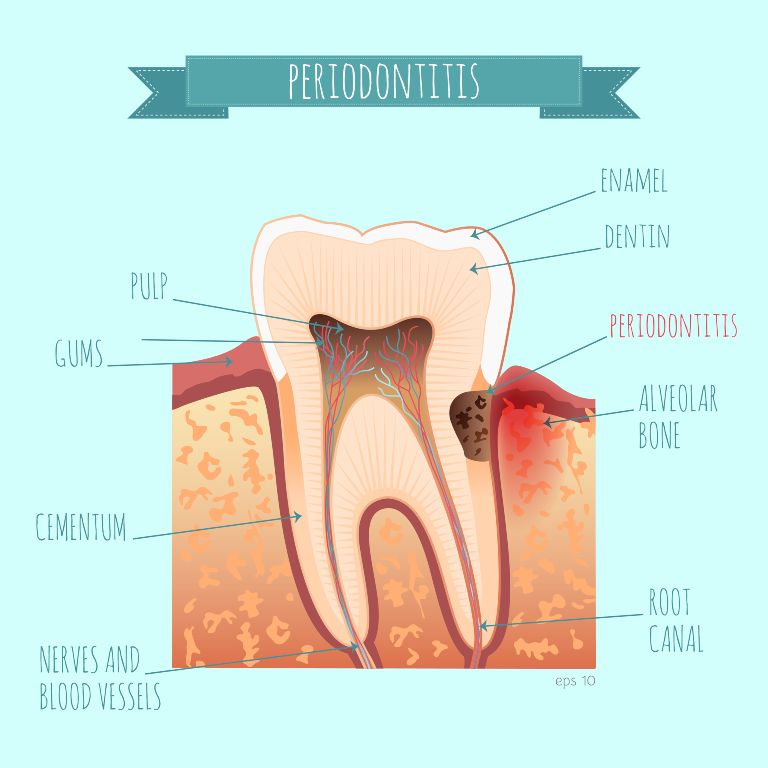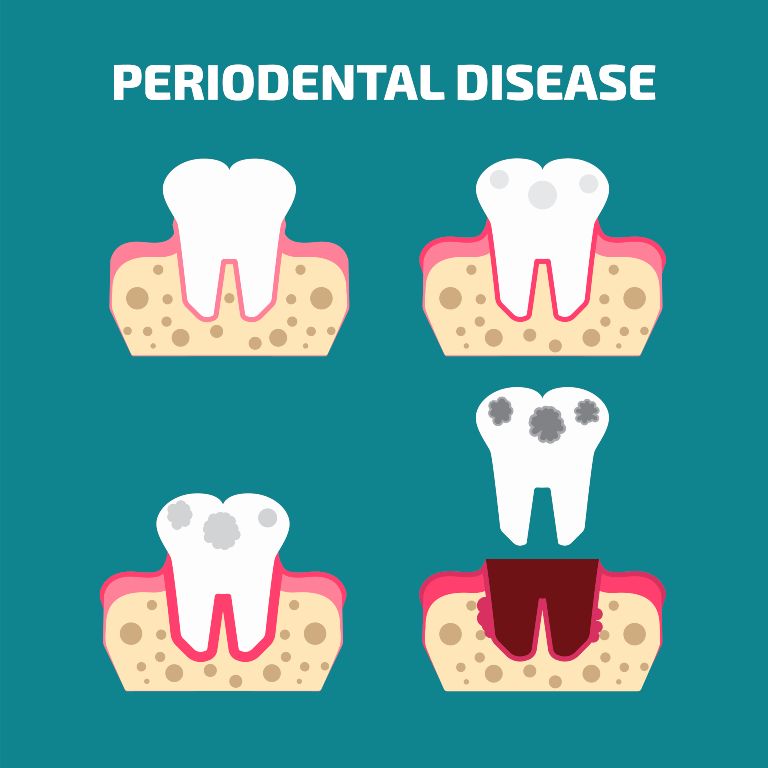Among great varieties of oral problems and diseases, dentists pay special attention to Periodontitis. Periodontitis, also known as gum disease, is a common and rather serious infection that usually infects and damages the soft tissue as well as the bone that supports the tooth. Without proper and early treatment, the alveolar bone around the teeth is gradually and progressively lost.
The name "periodontitis" comes from the Greek and means "inflammation around the tooth." Various microorganisms like bacteria, attach to the surface of the tooth and in the openings surrounding the tooth. There, they multiply and can cause serious damage. When our immune system starts to respond, toxins are released and inflammation happens.
If left untreated, periodontitis will ultimately result in severe tooth damage and loss. Periodontitis may greatly increase the risk of heart attack, stroke, and other major health problems. Bacterial plaque is a gluey and colourless membrane that develops over the cover of teeth. It is the most usual cause of periodontal infection. If plaque is not eliminated, it can strengthen to form calculus or tartar.
Periodontal disease (gum disease) is common but mostly preventable. Usually, it's the result of inadequate oral hygiene. In most cases, periodontitis is preventable and curable through regular and thorough oral hygiene. Brushing your teeth at least twice a day, flossing daily, and making routine dental checkups will immensely increase your chances of successful treatment.
Here are some main insights about this condition that will keep you well informed and aware of the dangers and possible treatments of this disease.
The most significant thing with periodontitis is that this gum disease may advance slowly and painlessly, producing less visible signs, even in the advanced stages of the infection. Even though the signs of periodontal disease oftentimes are subtle, the situation is not completely without any warning signs. Several symptoms can point to some form of the condition. The main symptoms of gum disease involve:
• Receding gums
• Red, tender, or swollen gums
• Constant bad breath, bad taste, or a change of flavor in the mouth
• Development of deep pockets in between gums and teeth
• Gums bleeding while brushing teeth. Gums bleeding after you brush your teeth.
• Shifts in the way teeth fit collectively upon biting down. Also, changes in the fit of partial dentures may happen.
• Loose or shifting teeth
Although you can't see any visible signs and symptoms, you may still have some stage of gum disease. In some people, periodontitis may affect and change only one particular tooth, such as the molars. That doesn't mean this issue should be taken lightly. Only your dentist or a specialist periodontist can identify this infection and determine the progress of gum disease. Therefore it is really important to have routine check-ups and proper oral hygiene.

Healthy people usually have several hundreds of various types of bacteria in their mouths. Most of them are completely harmless and they even help our body to a certain degree. Nevertheless, if you don't brush your teeth correctly every day, some bad bacteria form and grow upon your teeth.
Periodontitis is usually caused by inadequate oral hygiene. In most cases, the growth and spread of periodontitis first start with plaque — a sticky layer formed mainly of bacteria. When you don't brush your teeth correctly and don't can in hard-to-reach places of your mouth, the following can happen:
• Forming of plaque on your teeth - when sugar and starches in food combine with bacteria commonly found in your mouth, the plaque is formed. Brushing your teeth at least twice a day and flossing after every meal can remove plaque, but be aware - plaque can re-form rapidly.
• Plaque can grow below your gumline into tartar (calculus) if it lingers for a long time on your teeth. Tartar is more challenging to remove and it's loaded with bacteria. The longer tartar and plaque stay on your teeth, the severe damage they can cause. You can't clear tartar just by brushing and flossing - you'll need to seek expert dental brushing to eliminate it.
• Plaque can cause gingivitis - this is the lightest kind of gum disease. Gingivitis is inflammation and irritation of the section of your gum tissue around the bottom of your teeth (gingiva). Gingivitis can be cured and reversed with professional dental treatment and proper home oral hygiene.
• Continuous gum inflammation may cause periodontitis - this can eventually lead to the forming of the pockets between your gums and teeth that can fill with bacteria, plaque, and tartar. Over time, these nasty pockets grow deeper, overflowing with more and more bacteria. If not treated with care and on time, these deep infections may cause a loss of gum tissue and even tooth bone. Ultimately this may lead to severe gum deterioration and loss of your teeth. Additionally, continuous chronic inflammation can pose great stress on your immune system.
Some of the major factors that can increase the risk of periodontitis include:
• Bad and inadequate oral health practices
• Gingivitis
• Smoking cigarettes or chewing tobacco
• Changes in hormone levels, such as those associated with pregnancy or menopause
• Genetics
• Obesity
• Recreational use of drugs, such as smoking marijuana
• Bad nutrition, especially vitamin C deficiency
• Specific medications that create gum changes or dry mouth
• Certain diseases, such as rheumatoid arthritis, diabetes, and Crohn's disease
• Diseases that cause lowered immunity, such as HIV/AIDS, leukemia, and cancer treatment
Gingivitis happens before periodontitis and is the first stage of this gum disease. When we talk about gingivitis this usually implies gum inflammation, while periodontitis leads to gum disease and the destruction of bone, tissue, or both. Bacterial plaque grows on the surface of the teeth, making the gums turn red and inflamed. Sometimes your teeth may bleed while brushing. The gums become irritated and bothersome, only the teeth are still not loose. There is no irreparable damage to the tissue or the bone.
While there is no immediate threat to your oral health, untreated gingivitis can easily progress into periodontitis. Remember, if the inflammation persists there is no adequate periodontitis treatment at home, you'll have no choice but to go to the dentist.
That is why it is important to follow all instructions provided by your dentist. Your dentist will give you the best information and advice on how to use toothbrushes and dental floss correctly and may suggest other oral hygiene products like a mouthwash or water pick.
Here are several tips for getting rid of gingivitis and maintaining your teeth healthy:
• Brushing teeth twice a day with a fluoride toothpaste.
• Floss at least once a day to eliminate plaque.
• Think about using an electric toothbrush, because it can be more efficient.
• See your dentist every six months for professional cleaning.
• Don't smoke cigarettes or chew tobacco.
When doing professional cleaning, your dentist will use fluoride to eliminate plaque accumulation and tartar from your teeth and gums.
A deep-cleaning technique called scaling will help rub off tartar and also eliminate any uneven spots on the tooth root where bacteria tend to accumulate.
Sometimes, your dentist may prescribe antibiotics to aid with constant gum infections that didn't respond to cleanings. The antibiotic can be in the form of a gel, mouthwash, or an oral tablet.
Your dentist will require check-up with you after several weeks, and after to evaluate your progress. If periodontal pockets are still present, then your dentist may suggest different treatment options, like surgery.

The specific treatments that your surgeon or dentist may choose will heavily depend on the severity of the periodontal infection. That is why periodontitis treatment costs in Australia may vary from $140 to 3000 dollars.
First and foremost every good dentist will suggest non-surgical treatments in order to tackle periodontitis. Deep cleaning is the most common procedure that may cost between $140 and $300, depending on your dentist and your location. It is a routine procedure and you'll be able to resume drinking and eating that same day.
When it comes to slightly serious procedures that require deep cleaning your dentist may suggest surgical pocket reductions also known as "flap surgery". This method will make the mouth easier to cleanse and stop further infections from developing. "Flap surgery" usually costs between $1000 and $3000 without insurance. After surgery, you'll probably experience swelling up to 2 days. During that time you should take prescribed antibiotics and have a special diet made of soft food and liquid.
If your periodontal infection has produced a loss of gum tissue or bone, your dentist may advise bone or tissue grafts ion top of the surgical pocket reduction. This will help regenerate tissue or bone you lost. During bone grafting, your dentist will install synthetic or natural bone in the infected area which can help increase bone growth. A single procedure for tissue or bone grafts can cost around $600 to $1200. During recovery, don't use straws. You'll have to eat soft or liquid food for at least six to eight weeks.
Periodontal disease can increase your risk for conditions like heart disease, stroke, diabetes, and even respiratory diseases. If untreated, it can also result in tooth removal. It's extremely important to treat it with care and on time. If you start your treatment early, it can even save you from requiring more invasive procedures in the long run. This will help you save both your health and money.
Periodontal treatments and therapies are oftentimes exceptionally efficient, and as long as you understand and follow the instructions your dentist provides your risk of unnecessary complications is low. This involves thorough and proper oral hygiene as well as regular check-ups with your dentist.

